Spring plant list
Water-Efficient Plants in April, May and June
With blossoms, and the insects that pollinate them everywhere, spring is almost overload for the senses.
Below is a list of a few of our favorite spring beauties. All of these plants can be found growing at the Fair Oaks Horticulture Center.
For more information about what’s going on at the Fair Oaks Horticulture Center, please visit Water-Efficient Landscape Gardens. To learn about the UC Davis Arboretum All-Stars, many of which can be seen at the WEL gardens, go to UC Davis Arboretum All Stars.
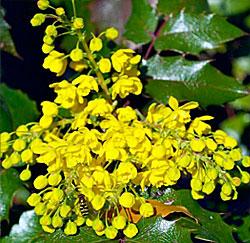
|
Berberis aquifolium var. repens The ‘Compacta’ variety of this evergreen native shrub is another UC Davis All-Star. Brilliant yellow spring blossoms mature into lovely dark purple grape-like clusters that provide food for native birds in the fall. Preferring part shade/ to shade it is a welcome addition to the garden both as an easy care plant and for it’s value in attracting beneficial insects and wildlife. |
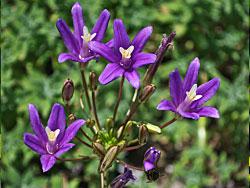
|
Brodiaea californica This late spring blooming California native bulb prefers no summer water. Tolerant of many soil types, it bears showy, open flower heads on stalks up to 2 feet tall that make good cut flowers. Flowers usually appear after the spring leaves die back. Several hybrid Brodiaea are also growing through out the garden including ‘Queen Fabiola’and Triteleia laxa ‘Rudy’ |
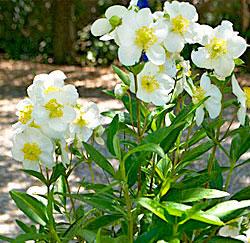
|
Carpenteria californica 'Elizabeth' This attractive, evergreen California native grows slowly to 4 to 8 feet tall and wide. Leaves are deep green. In late spring clusters of scented white flowers appear at branch ends. It accepts ordinary garden conditions, and plants can take garden water, but are quite drought tolerant once established. They appreciate a little shade from hot afternoon sun. Left unpruned, they grow into rounded mounds. |
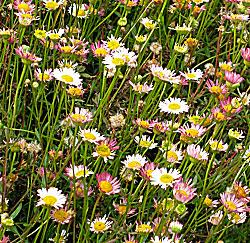
|
Erigeron karvinskianus These low growing, quickly spreading, adaptable perennials (native to Mexico) are covered with cheerful, long lasting, pink tinged small daisy shaped flowers which start blooming in spring. If sheared back, they rapidly rebloom. They may aggressively spread, but are easily removed. They do best in well drained, sunny locations but will accept some shade and require little water. |
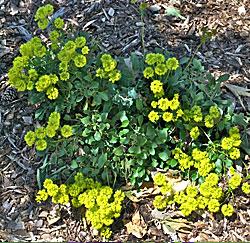
|
Eriogonum umbellatum var. polyanthum This native of Northern California mountain areas adapts well to our climate and soil. It grows as a mounding small semi-evergreen sub-shrub 1½ feet tall to 3 feet wide. The bright yellow pom-pom like spring blossoms dry to a long lasting sulfur colored seed head. It can tolerate some shade and prefers good drainage. |
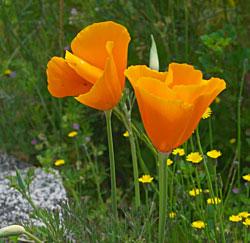
|
Eschscholzia californica Our beloved state flower is an easy to grow annual. In fact if it is happy, it will reseed abundantly. After the first wave of blossoms it can be cut or mowed to one inch stems and watered for rebloom. |
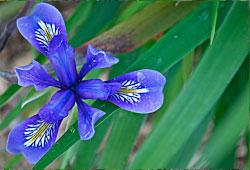
|
Iris douglasiana Pacific Coast hybrid irises are the descendants of years of hybridizing (by plant breeders since the 1920s) using the wild iris, Iris douglasiana, found primarily along the coast from southwestern Oregon south to Santa Barbara. Many of these hybrids grow well with little maintenance in well drained soil, with low summer water and shade from the hot afternoon summer sun. The white "Canyon Snow' is a UC Davis Arboretum All-Star. |
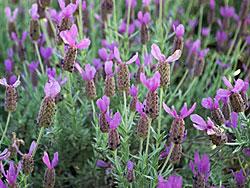
|
Lavandula stoechas 'Otto Quast' This showy, shrubby lavender, thrives in our sunny, dry climate. A favorite of bees, butterflies and other beneficial insects, it starts blooming in early spring. |
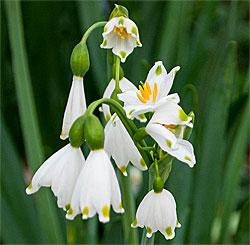
|
Leucojum aestivum This bulb grows strappy dark green leaves about 12 inches long, with many flowers on stems reaching 12 to 15 inches in height. The pendulous bell-shaped, green dotted white flowers are less than an inch in length. Though called Summer Snowflake, Leucojum aestivum is dormant in the summer. It blooms from February to early April. They naturalize happily and are now found throughout the world. Although Leucojum prefers medium water, it survives under dryer conditions, as long as the dormant plants are covered with mulch during hot summer months. It thrives in sun or shade, tolerates any soil and needs little maintenance, other than dividing every few years. There are no serious pest or disease issues reported. |
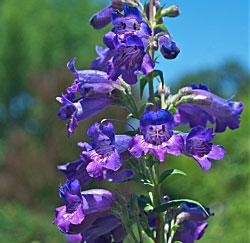
Penstemon 'Midnight'
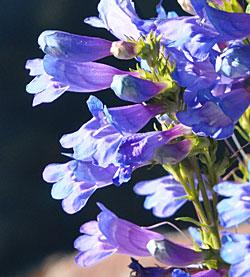
Penstemon 'Margarita B.O.P.'
|
Many of these primarily North American natives have been hybridized in Europe since the 1800s and returned to the United States where their popularity is now on the rise. They are drought tolerant, sun loving, showy perennials with tubular flowers in many colors on tall stalks that require well drained soil. Beloved by hummingbirds, they bloom all summer long with deadheading. We have at least eight varieties blooming in our garden including the California native Penstemon heterophyllus ‘Margarita B.O.P.’ (a UC Davis Arboretum All-Star) and the Penstemon hybrid ‘Midnight’ shown here. |
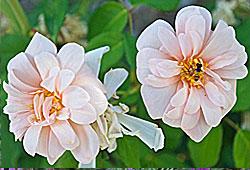
|
Rosa 'Perle d'Or' Dating from 1884, this drought tolerant, virtually pest free relatively thornless, fragrant shrub rose sports clusters of apricot colored blossoms almost year round. Another UC Davis Arboretum All-Star, it requires full sun and pruning to shape in the winter. |
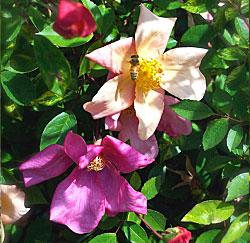
|
Rosa x odorata 'Mutabilis' The Butterfly rose is a large shrub rose that's a UC Davis Arboretum All-Star for good reason. First noted by European botanists in 1896, it likely originated in China. It blooms nearly year round and attracts bees and other beneficial insects. It does well with less water, and tolerates our soils. Although this rose can tolerate some shade, it does not do well in windy sites. Attractive blooms begin as scarlet buds and mutate progressively into light yellow, then pink, then crimson blossoms (that some have likened to butterflies). Newly sprouted canes are deep red, complementing the flowers and the lush foliage. Nearly maintenance free, Mutabilis can be pruned in winter to keep the plant more compact. |
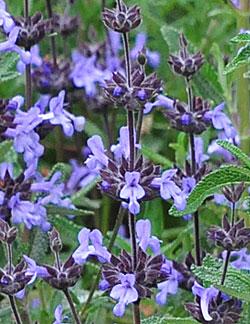
|
Salvia brandegeei 'Pacific Blue' ‘Pacific Blue’ can grow to 4 to 6 feet high and wide in garden conditions. Its deep green leaves have velvety white undersides and a light fragrance. Flowers appear in March and April, clustered in whorls around the stems, attracting hummingbirds, butterflies, and bees. Salvia brandegeei prefers full sun, is drought tolerant and cold hardy to 15 degrees Fahrenheit, and tolerates a wide range of soils from clay to sand. It can be propagated easily from seed or cuttings. When young, it can be kept dense by cutting back in winter by about one third; mature plants should simply be tip pruned. |
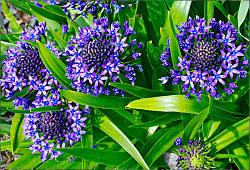
|
Scilla peruviana This summer-dormant bulb with enchanting, long lasting spring blooms that attract bees is a native of the Iberian peninsula, Italy and North Africa, not Peru. (Carolus Linnaeus in 1753 was mislead by the name of the ship, Peru, which delivered original specimens to him to name.) It requires sun, good drainage and little summer water, and will naturalize. |



